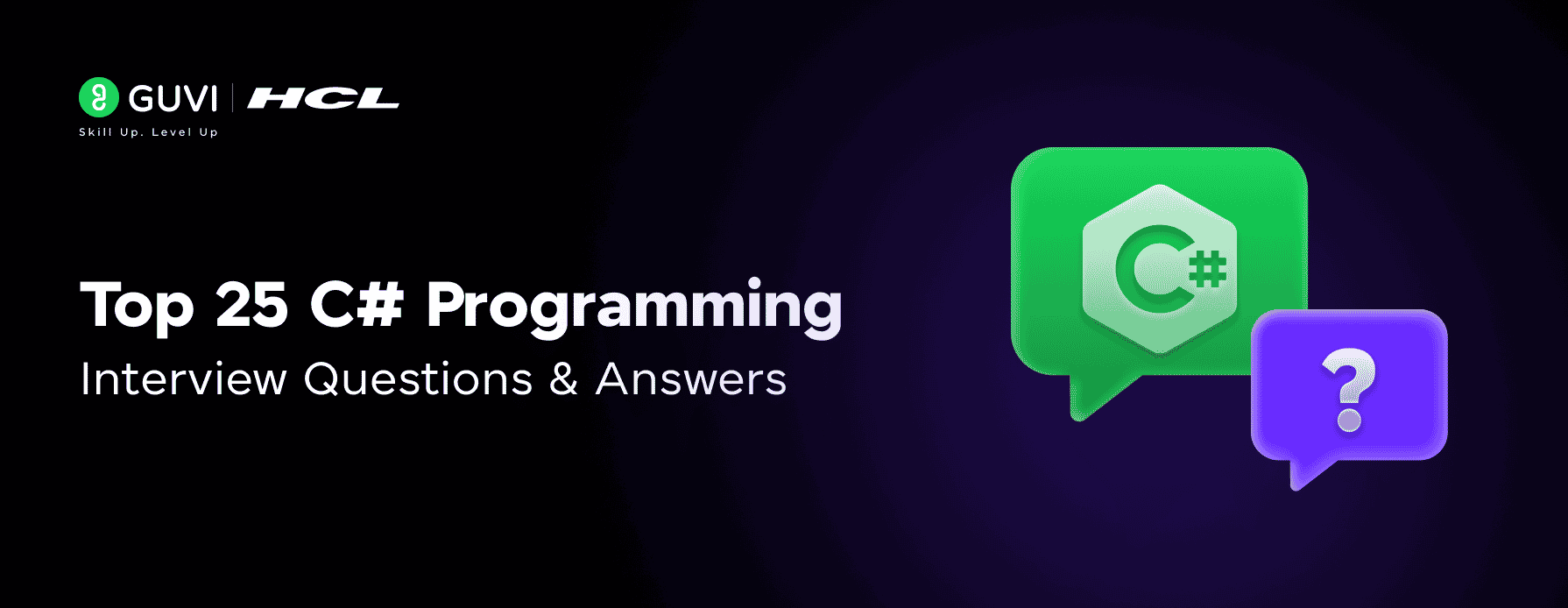
Top 25 C# Interview Questions and Answers
Oct 10, 2025 7 Min Read 2523 Views
(Last Updated)
Are you a fresher or an experienced person who has a technical interview upcoming? Are you nervous about it? We got you covered!
This blog covers the top 25 C# interview questions and answers for your upcoming technical interview at different levels. It also mentions the important C# interview concepts, making this blog a perfect last-minute guide to ace your interview. Let’s get started!
Table of contents
- Important C# Interview Concepts
- Top 25 C# Interview Questions and Answers
- Freshers Level
- Intermediate Level
- Expert Level
- Scenario-Based Questions
- Conclusion
- FAQs
- Q1. Is C# still relevant for interviews in 2025?
- Q2. Do companies test collections or built-in libraries in C# interviews?
- Q3. Do C# interviews include .NET-specific questions?
- Q4. Is LINQ important for C# interviews?
Important C# Interview Concepts
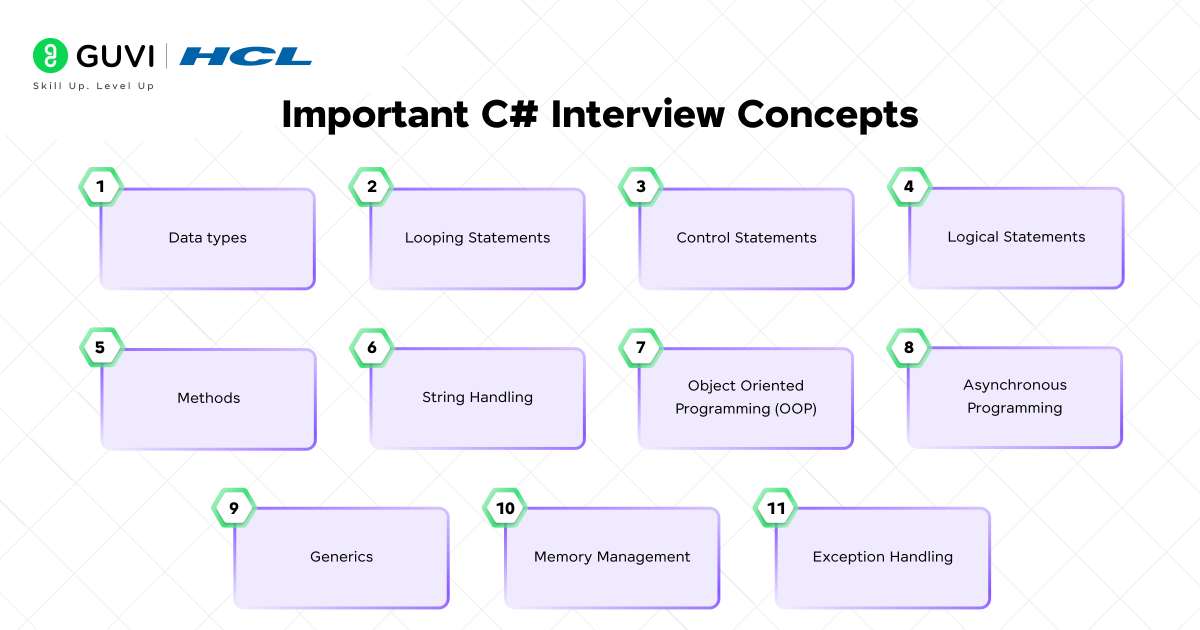
Before jumping into the actual C# interview questions and answers, let’s take a moment to understand the important C# concepts that are frequently asked in the interview. Let’s jump into it.
- Data types: It is a fundamental concept for a programming language. It defines the kind of data a variable can hold. C# supports a variety of data types like
int,float,char, andbool. - Looping Statements: It allows you to repeatedly execute a block of code until the condition is
false. These statements are essential for tasks like iterating over arrays, and repetitive calculations. Looping statements includefor,while,do...while. - Control Statements: This statement manages the executional flow based on conditions. It includes
if,else,switch,break,continue, andgoto, enabling decision-making and branching in code logic. - Logical Statements: It uses operators like
&&,||, and!to form complex conditional expressions. These statements are used in control flows to determine whether the conditions are true or false. - Methods: It defines a reusable block of code that performs specific actions. C# supports parameters such as ref, out, in, and params
- String Handling: It involves managing and manipulating text data. C# strings are immutable, and it include operations such as concatenation, formatting, and comparison. StringBuilder helps in efficient modification.
- Object Oriented Programming (OOP): C# is an OOP language that includes four main pillars, such as encapsulation, inheritance, polymorphism, interfaces, constructors, and abstraction. These principles help to organize and maintain code.
- Asynchronous Programming: It allows the code to run without blocking the main execution. It uses async and await keywords to handle time-consuming operations.
- Generics: It enables type-safe data structures and methods without specifying exact data types during design time by using placeholders like
<T>. - Memory Management: C# provides both manual and automatic memory management. Proper memory management is crucial to avoid memory leaks and segmentation faults.
- Exception Handling: try, catch, and throw blocks are used to handle exceptions and manage runtime errors in C#.
Top 25 C# Interview Questions and Answers
In this section, we will cover top 25 C# interview questions and answers for different experience levels from freshers to experienced people. This covers various questions from the important interview concepts mentioned above. Let’s jump into it.
Freshers Level
- Difference between C and C#
| C | C# |
| It is a procedural programming language | It is an object-oriented programming language |
| It uses manual memory management using malloc, free | It complies with intermediate language(IL) |
| It compiles directly to machine code | It is faster since it is closer to the hardware |
| It is platform-dependent | It is slower due to runtime overhead |
| It is platform-independent | It is platform independent |
- What are the main features of C#?
C# is an object-oriented language that supports OOP principles such as inheritance, polymorphism, encapsulation, and abstraction. Additionally, the features include:
- It prevents type eros at compile time
- It ensures memory safety during runtime
- It provides a rich standard library for .NET
- It provides automatic garbage collection through the .NET CLR, reducing memory leaks
- It supports async/await for non-blocking operations
- It includes features like properties, delegates, events, and pattern matching
- What is the purpose of the var keyword?
The var keyword is used for implicit type declaration in C#. In other words, the compiler automatically determines the variable type based on the assigned value during compile time.
- What is a class and an object?
Classes are the blueprints for creating objects. It defines attributes and methods that describe the behavior of an object.
An object is an instance of a class. Classes contain the blueprint where objects hold the actual values for the attributes and be able to perform the methods.
For example, Animal is a class that describes what an animal is and its general qualities, such as breathing, can eat, and sleep. A specific animal, such as a dog or, cat, is an object of the animal class.
- What are Generics?
Generics in C# allow to creation of classes, interfaces, methods, and delegates with a placeholder for the data type. This ensures type safety, reusability, and efficient coding without sacrificing flexibility. It is performance-friendly by avoiding boxing and unboxing for value types.
| public class Box<T> { public T Value; } |
- What are the types of classes in C#?
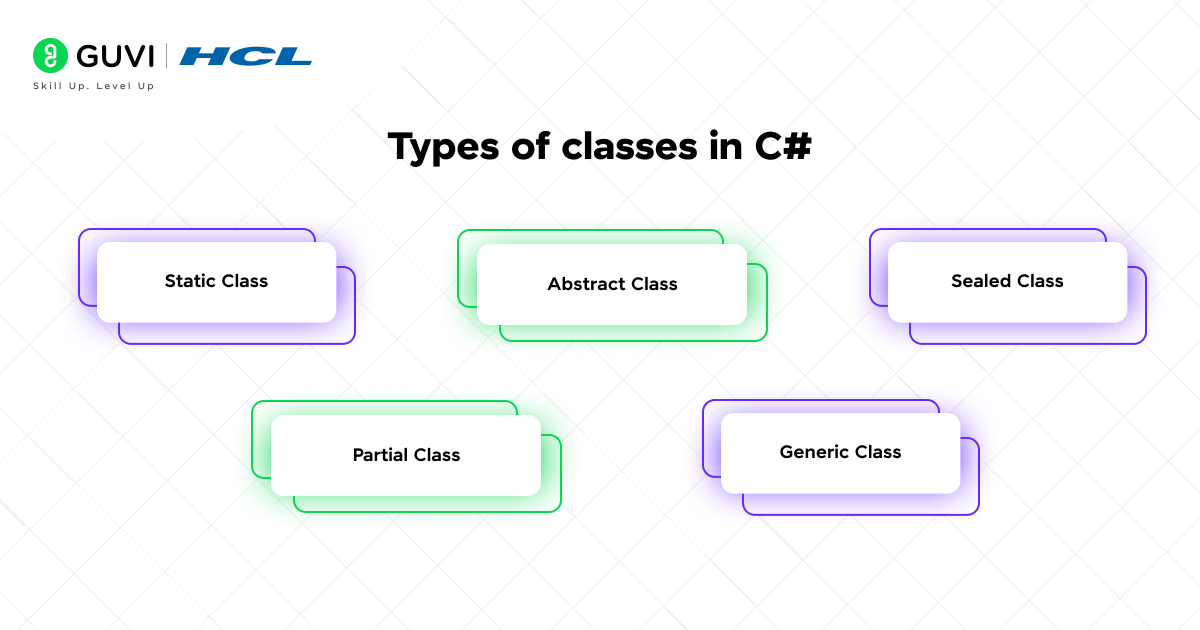
There are many types of classes in C#. Some of the common types are:
- Static Class: It cannot be instantiated or inherited, and it contains only static members
- Abstract Class: It also cannot be instantiated, but it must be inherited and may contain abstract members
- Sealed Class: It cannot be inherited and used to prevent further derivation
- Partial Class: It is split across multiple files and combined during compilation
- Generic Class: It uses generic type parameters
- What is Inheritance in C#? Does C# support Multiple Inheritance?
Inheritance is the process of inheriting properties and behaviour from one class (parent or base class) to another class (child or derived class). It is used for code reuse, easy maintenance, and hierarchical establishment.
No, C# doesn’t support multiple inheritance. It is to avoid ambiguity and complexity, such as the diamond problem. This means a class in C# cannot extend more than one class.
Intermediate Level
- What is the difference between String and StringBuilder?
String | StringBuilder |
| It is immutable | It is mutable |
| It is slow for repeated modifications | It is fast for frequent string modifications |
| It uses System namespace | It uses System.Text namespace |
| It creates a new object on each change | It modifies the same object in memory |
- Difference between == and Equals() method in C#?
| Equal Operator (==) | Equals() |
| It compares the values | It compares the values or content |
| It cannot be overridden but can be overloaded | It can be overridden |
| It is safe to use with null | It throw error if called on null |
- What is the difference between late binding and early binding in C#?
| Early Binding | Late Binding |
| It is also known as static binding | It is also known as dynamic binding |
| It binds with the class during collection time | It binds with the class during execution time |
| Example: Method overloading | Example: Method overriding |
- What is boxing and unboxing in C#?
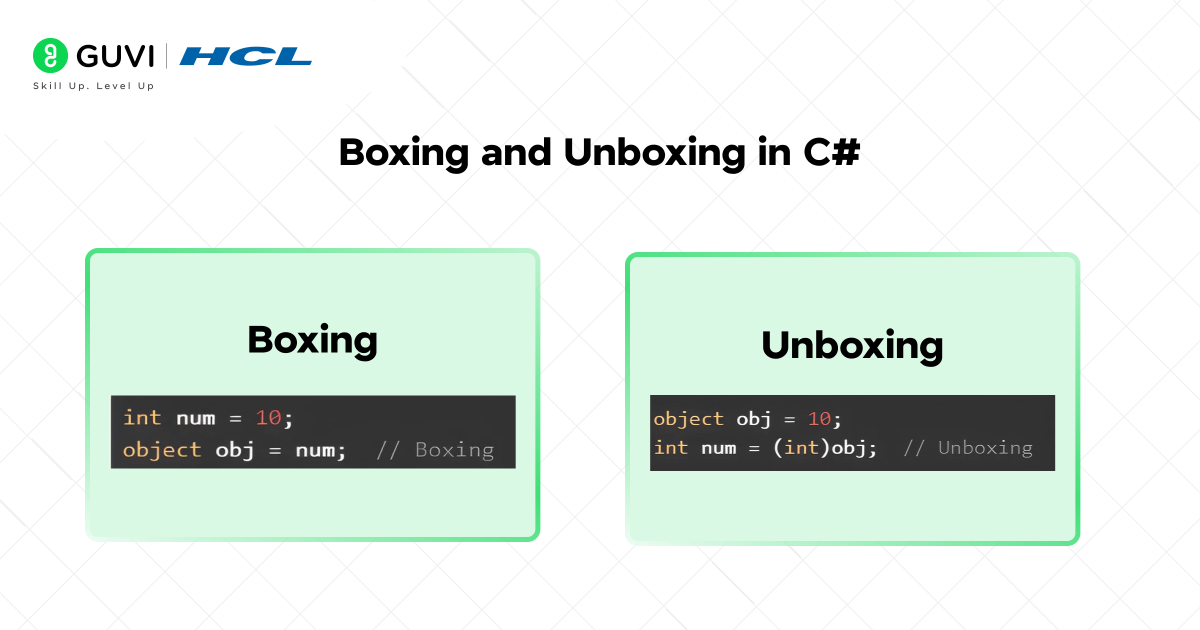
Boxing: It is a process of converting a value type, such as int, float, or bool, into a reference type, such as object.
Example:
| int num = 10; object obj = num; // Boxing |
Unboxing: It is the reverse process of extracting values from the object types.
Example:
| object obj = 10; int num = (int)obj; // Unboxing |
- Write a C# program to find the substring from a given string.
| internal static void findallSubstring(string str){ for(int i = 0; i < str.Length; ++i){ StringBuilder subString = new StringBuilder(str.Length – i); for(int j = i; j < str.Length; ++j){ subString.Append(str[j]); Console.Write(subString + ” “); } } } |
- Write a C# program to reverse a string.
| using System; class ReverseString { static void Main() { Console.WriteLine(“Enter a string to reverse:”); string input = Console.ReadLine(); string reversed = “”; for (int i = input.Length – 1; i >= 0; i–) { reversed += input[i]; } Console.WriteLine(“Reversed string: ” + reversed); } } |
- What is the difference between List and Dictionary in C#?
List<T> | Dictionary<TKey, TValue> |
| It stores items in a linear format | It stores elements in a key-value pair |
| The elements can be accessed based on a key | It takes O(N) for the element |
| It allows duplicate values | The keys must be unique |
| It takes O(1) for key-based searching | It takes O(1) for key based searching |
- What is garbage collection in C#?
Each object consumes memory to initiate and function. So if the object memories are not handled perfectly, it may lead to memory-related errors, and the system might fail.
To avoid these issues, garbage collection is used to handle the memory in the program. Through garbage collection, the unwanted memory is freed up by removing the objects that are no longer needed.
C# supports automatic garbage collection provided by the .NET runtime (CLR). It reclaims memory used by objects that are no longer reachable or needed.
Expert Level
- What is the static keyword?
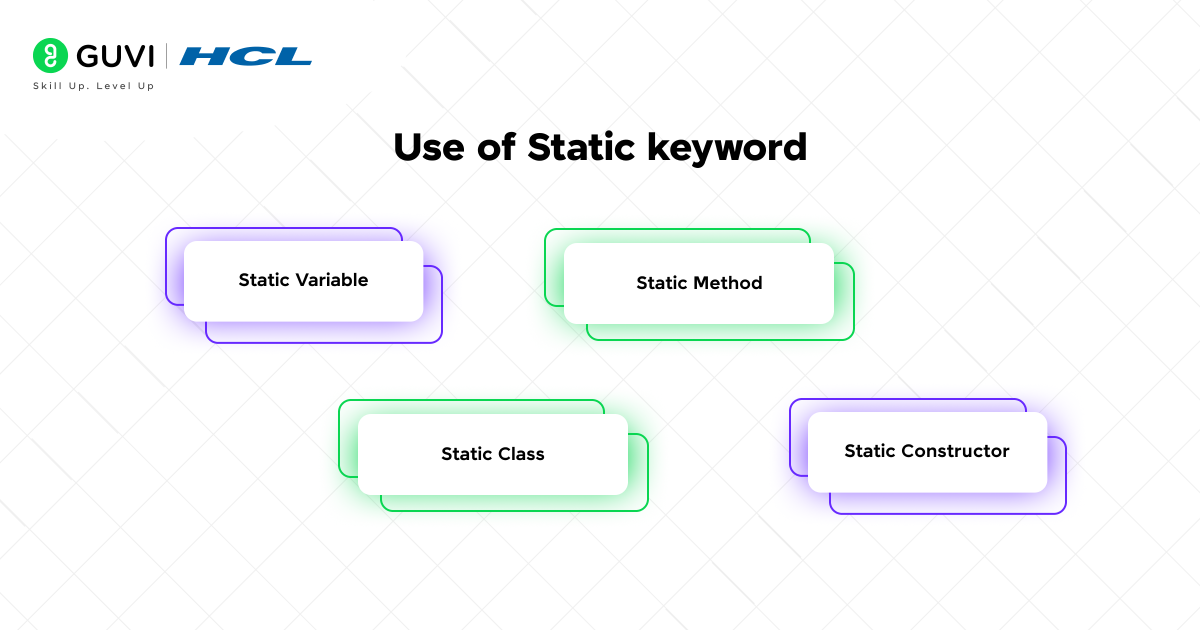
The static keyword in C# is used to declare the members, classes, variables, or constructors that belong to the type itself, rather than to any specific object of the class. The uses of the static keyword include:
- Static Variable: It can be shared by all instances of the class ,and only one copy exists in the memory
- Static Method: It can be called without instantiating. It cannot access nonstatic members
- Static Class: It cannot be instantiated and contains only static members
- Static Constructor: It initializes static data. It is called automatically before any static member
- What is the difference between constants and readonly?
| Constants | Readonly |
| It must be assigned at compile time | It can be assigned at runtime |
| It is used only with primitive data types | Use a constant when the value is universal and fixed |
| It cannot be changed once compiled | It cannot change after construction |
| Example: const int X = 10; | Use readonly when the value is set at runtime |
| Example:const int X = 10; | Example:readonly int Y = DateTime.Now.Second; |
- What are the access modifiers in C#? Mention its types
Access modifiers or access specifiers define the visibility of class attributes and methods. In general, there are three types of access modifiers. They are,
- Public: The attribute or method can be accessed from anywhere, i.e., from both within and outside the class.
- Private: The attribute or method can be accessible within the class only.
- Protected: The attribute or method can be accessible within the class and its derived classes.
- Internal: It can be accessed only within the same assembly or project.
- How is exception handling done in C#?
Exception handling is a method to handle the program when the software or code fails to execute its work. Before failing, the exception handling will execute and prevent it from stopping.
Exception handling in C# is done using the try, catch, finally, and throw keywords.
- try: It wraps the code that might throw an exception
- catch: It catches and handles the exception.
- Finally, It always runs after try/catch, whether there is an exception or not. It is used for cleanup.
- throw: It is used to manually raise an exception. It can re-throw the caught exceptions once again.
Example:
| using System; class Program { static void Main() { try { int num1 = 10; int num2 = 0; int result = num1 / num2; // Will cause DivideByZeroException } catch (DivideByZeroException ex) { Console.WriteLine(“Error: ” + ex.Message); } finally { Console.WriteLine(“This will always execute.”); } } } |
- What is LINQ in C#?
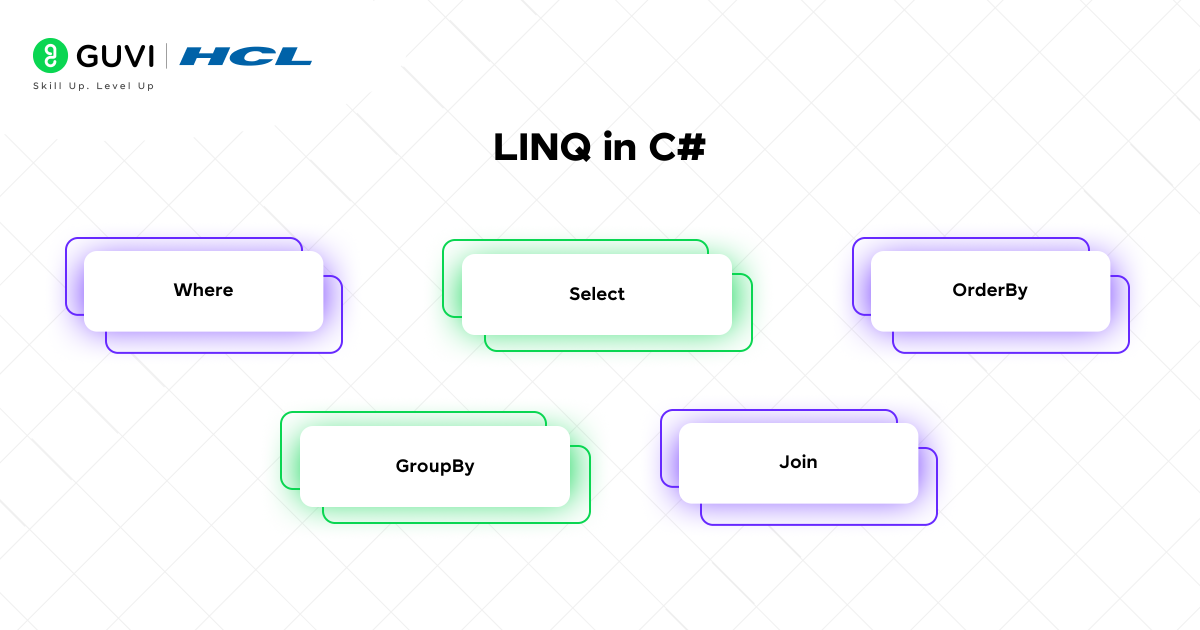
Language Integrated Query (LINQ) is a feature in C# that allows you to write queries directly within your C# code in SQL syntax format. With the help of LINQ, manipulating data from various sources such as collections, databases, and XML documents will be consistent. It supports tasks like filtering, sortin,g and aggregating data. Some of the common LINQ operators include:
- Where: It is used to filter data based on certain criteria
- Select: It transforms data by projecting new format
- OrderBy: It sorts data in either ascending or descending order
- GroupBy: It groups data based on a key
- Join: It combines data from multiple sources based on a key
Get started with C# by enrolling in HCL Guvi’s C Sharp with .NET Course. This course provides a detailed overview on C# and how .NET is implemented using C sharp.
- What is reflection?
Reflection in C# is the ability of a program to examine and modify its structure at runtime. It dynamically discovers and interacts with types, methods, properties, and other metadata without compile-time knowledge. It relies on System.Reflection namespace, which provides various classes for inspecting and manipulating the metadata at runtime. It is a perfect example of late binding.
Scenario-Based Questions
- How will you remove the tight coupling between two classes?
To remove tight coupling between two classes in C#, you can use abstraction and dependency injection. Instead of one class directly creating or depending on another concrete class, define an interface that the dependent class relies on. Then, inject the actual implementation through the constructor, method, or property.
This approach promotes loose coupling, making the code more flexible, testable, and maintainable. It also follows the Dependency Inversion Principle, where high-level modules depend on abstractions, not concrete implementations.
- How is memory managed in C#?
In C#, memory is managed using the stack and the heap data structure. The stack stores value types and method call information, such as local variables and parameters. It operates in a last-in, first-out manner, allowing fast allocation and deallocation when methods are called and returned.
The heap, on the other hand, stores reference types like objects and arrays. Memory on the heap is dynamically allocated and persists as long as there are references to the objects.
The Garbage Collector (GC) in C# automatically manages heap memory by periodically identifying and freeing objects that are no longer referenced, using a generational approach to optimize performance. This automatic process helps prevent memory leaks and simplifies programming by removing the need for manual memory management.
- How do you swap two numbers without using a third variable?
Before writing code, provide a detailed explanation of your thought process and approach to the interviewer.
| void SwapNumbers(ref int a, ref int b) { a = a + b; b = a – b; a = a – b; } |
- How do you implement a Stack in C#?
| Stack<int> stack = new Stack<int>(); stack.Push(1); stack.Push(2); Console.WriteLine(stack.Pop()); // Output: 2 |
Conclusion
In conclusion, this blog is the perfect last-minute guide to ace your C# programming technical interview. It covers C# topics ranging from data types, object-oriented programming, memory management, methods, asynchronous programming, generics, and exception handling. Mastering these concepts will not only help you in acing .NET developer roles-related interviews but also help you in other roles that require C# programming. Happy Learning!
FAQs
Q1. Is C# still relevant for interviews in 2025?
Yes, C# is very much relevant, especially for roles involving enterprise application development, backend services, desktop applications, and game development (Unity). Many companies using the .NET ecosystem include C# in technical interviews to assess object-oriented design, code quality, and problem-solving skills
Q2. Do companies test collections or built-in libraries in C# interviews?
Yes, interviewers often expect you to use built-in C# collections like List<T>, Dictionary<TKey, TValue>, HashSet<T>, and LINQ Methods for solving problems. Understanding how these data structures work under the hood can give you an edge in algorithmic rounds.
Q3. Do C# interviews include .NET-specific questions?
yes. For roles focused on .NET development, expect questions on ASP.NET Core, Entity Framework, dependency injection, and middleware. Understanding how C# fits within the .NET ecosystem is key for success in full-stack or backend positions.
Q4. Is LINQ important for C# interviews?
Definitely. LINQ simplifies querying and manipulating data collections. Many interview problems can be solved elegantly using LINQ methods like Where(), Select(), GroupBy(), and Aggregate(). Mastery of LINQ showcases both your functional programming and problem-solving skills.




































Did you enjoy this article?